MXA RACE TEST: THE REAL TEST OF THE 2019 SUZUKI RM-Z450
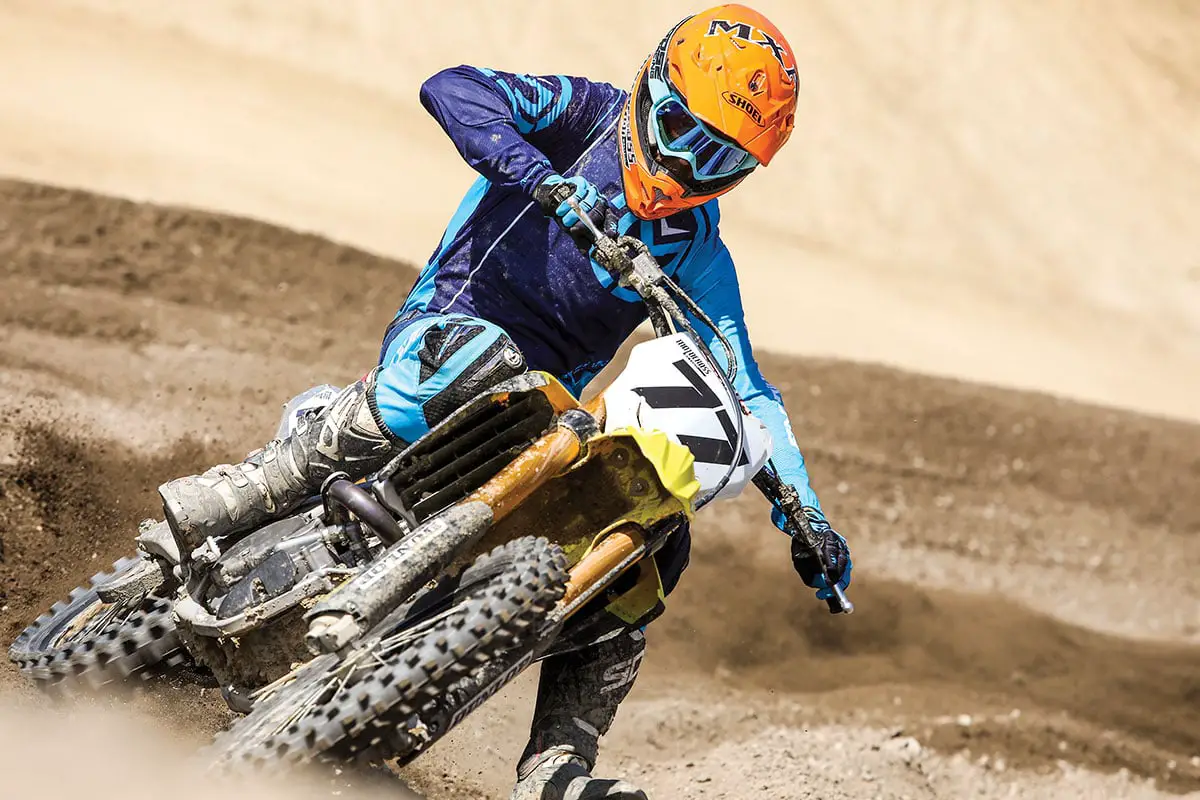
Q: FIRST AND FOREMOST, IS THE 2019 SUZUKI RM-Z450 BETTER THAN THE 2018 RM-Z450?
A: Yes, but since the RM-Z450 was all new in 2018, the Suzuki engineers just tried to Band-Aid the minimum number of problem areas for 2019. There is nothing wrong with this strategy, because Yamaha was especially successful on the 2019 Yamaha YZ450F with a little more than beefier axle lugs on the front forks. So, while most critics turn their noses up at the very short list of changes on the 2019 Suzuki, MXA isn’t among them. Maybe the list of mods isn’t much to cheer about on paper, but on the track we felt some improvement to the shock, forks and overall chassis response, with little more than a softer and shorter shock spring and updated damping force settings. Is the 2019 Suzuki RM-Z450 a lot better than the 2018 model? No, but it is better.
Q: WHAT IS THE BEST PART OF THE 2019 SUZUKI RM-Z450?
A: It’s no secret that MXA test riders like the Suzuki RM-Z450 powerband. We have gone so far as to say that the Suzuki RM-Z450 has almost perfect power placement for the average rider. That doesn’t mean that it is faster than the competition, because it isn’t; however, from 5500 rpm to 8900 rpm, it can run with the big dogs in terms of horsepower and torque. When used properly, the stock 2019 engine can get the job done—unless you are a rev ranger. For riders who love to wring their powerbands out until the rev limiter has an epileptic fit, the Suzuki lacks any top-end power. It gives up the ghost at 8900 rpm and starts to lose its juice almost immediately.
That doesn’t disqualify the 2019 RM-Z450 as a race bike, though, because when short-shifted, kept in the meat of the powerband and used properly, it has a manageable, drama-free, effective 450cc powerband. It is brisk off the bottom and at its strongest at the part of the curve where acceleration is generated. This is a very heavy bike, but the weight isn’t a deal-breaker. The rest of the bike is just a tick off everywhere.
This is a very heavy bike, but the weight isn’t a deal-breaker. The rest of the bike is just a tick off everywhere.
Q: HOW DOES THE 2019 SUZUKI RM-Z450 RUN ON THE DYNO?
A: If we are talking peak horsepower numbers, Suzuki should hang its head in shame. Its lowly 54.39 horsepower at 8900 rpm is 5.82 horsepower less than the 2019 CRF450, 3.12 horsepower less than the YZ450F, 2.75 horsepower less than the KTM 450SXF, 2.01 horsepower less than the Husky FC450 and 1.47 horsepower less than the KX450. The reason for the poor dyno numbers can be traced to the lack of high-rpm power. Whereas the other brands are peaking from 9500 rpm to 10,000 rpm, the Suzuki starts falling off the map at 8800 rpm. You don’t even want to know how big a dive the RM-Z450 takes after it reaches its peak, but suffice it to say that the 2019 Honda CRF450 produces 8.85 more horsepower than the RM-Z450 at 10,000 rpm. If you try to race your RM-Z450 head-to-head against a red, green, orange, blue or white bike in a high-rpm tango, you will lose. The message? Stay within the Suzuki RM-Z450’s power profile—leave it at your own risk.
Q: HOW GOOD IS THE 2019 SUZUKI RM-Z450 CHASSIS?
A: Ingrained in the vast reservoir of worthless knowledge that motocrossers collect is the tidbit about Suzukis being the best turning bikes on the track. That is true—or more accurately, that was true until the 2018 RM-Z was released. Suzuki grabbed for the brass ring and fell off the merry-go-round in 2018. In an effort to maximize its reputation as the best-turning bike made, it produced a motocross chassis that, for lack of a better explanation, turned too well. It oversteers like a unicycle. The front end bites. The rear steps out, and the whole chassis shakes like a dog with fleas.
It is out of balance and has a stinkbug rear end that transfers too much weight to the front wheel. The goal for an aspiring 2019 Suzuki RM-Z450 racer is to get the rear end down and the front end up. To their credit, Suzuki’s engineers seem to recognize the part that they played in the oversteer equation. So, for 2019 they put on a softer and shorter shock spring. This allowed the rear end to drop a little farther into its stroke. It helped with the feel of the rear shock but mostly transferred weight rearward to lessen the front end’s overbite. The owner/racer has to do his part also—unless he likes head shake at high speed and corkscrewing into the ground at low speed. The racer needs to set the race sag from between 105 to 110mm and, as the racer lowers the sag, he needs to slide the forks down into the triple clamps. How far down? Flush would be about right. You’ll know when and where to stop because the chassis will be flatter to the horizon. The front end won’t feel like it is tucked under your buns, and you won’t be correcting for oversteer with a lot of countersteer. The onus is on the racer to find his sweet spot. The only clue that we can offer is that it is nowhere near where Suzuki thought it was.
We ran a longer shock linkage than the stock 135mm link. That lowered the rear of the Suzuki and stiffened up the initial part of the shock stroke, which allowed us to have more options in compression, rebound settings, fork height and head angle. We can only advise you on what to do to your 2019 Suzuki chassis, but be forewarned that if you don’t touch it, it will never get better.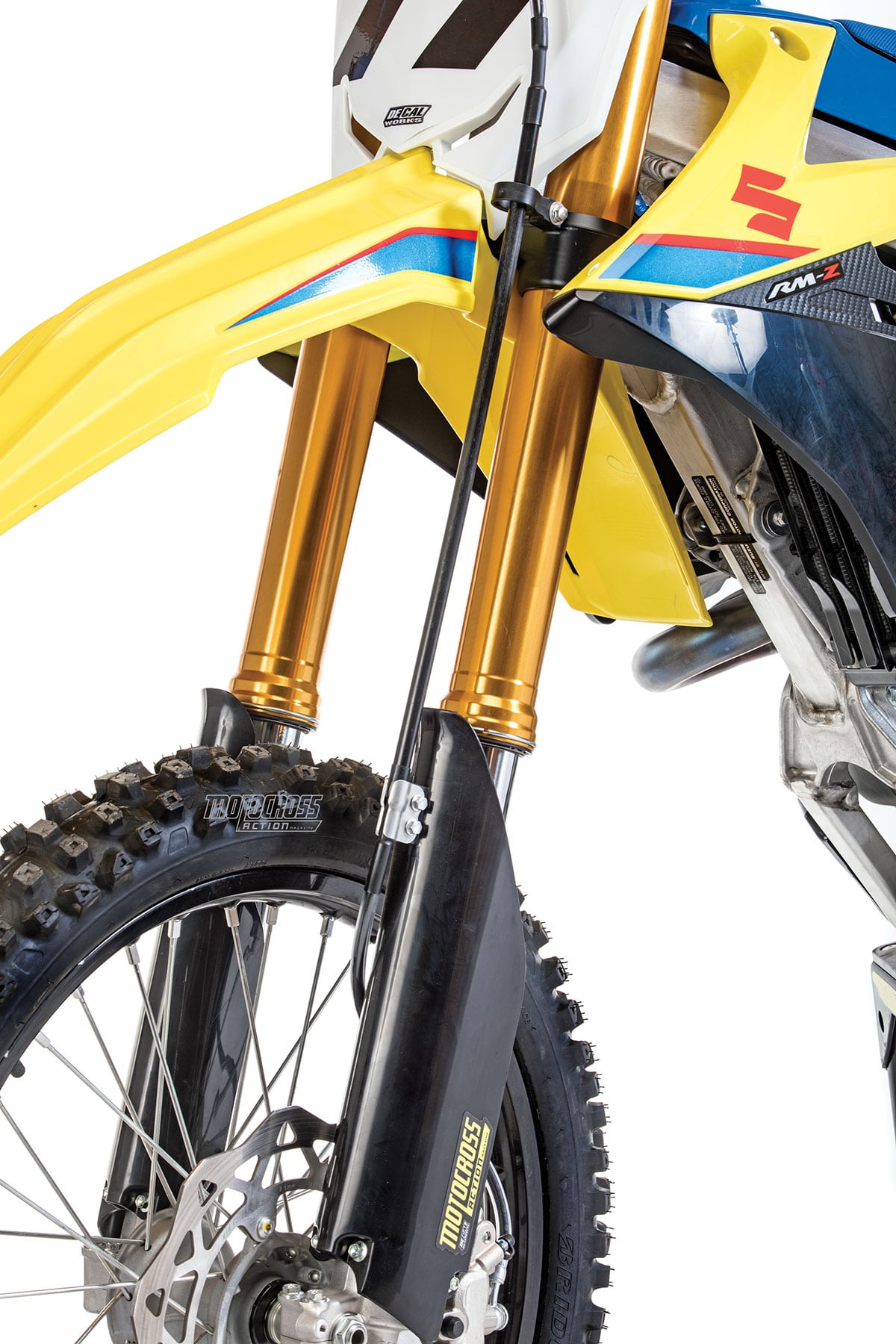 The RM-Z450 forks share a lot in common with the KX450 and CRF450 fork.
The RM-Z450 forks share a lot in common with the KX450 and CRF450 fork.
Q: HOW GOOD ARE THE NEW COIL-SPRING SHOWA FORKS?
A: Kawasaki, Honda and Suzuki share the same basic 49mm Showa coil-spring forks. We can’t say that we like them very much, but we can’t say that we hate them—because they are much better than what the RM-Z450 put us through during the air-fork era. These forks can easily be fixed. In fact, the 2019 Kawasaki KX450’s version of the Showa fork is much better than the Suzuki’s version, and the Suzuki’s version is better than the Honda’s version. While the KX450 forks are the plushest of the trio, they are too soft. Suzuki forks move too quickly through the mid-stroke but then spike back at the end of the stroke.
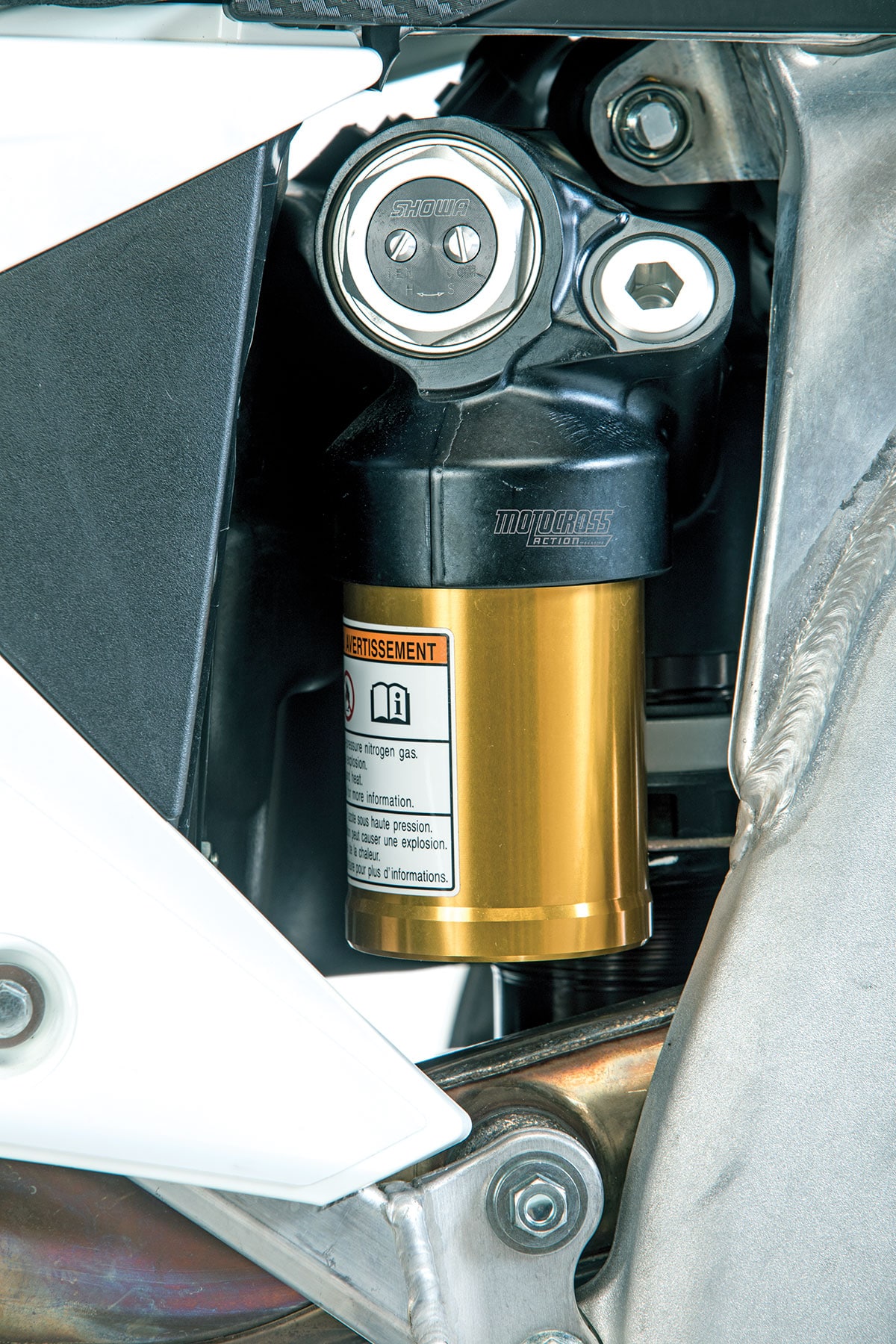
Q: HOW GOOD IS THE SHOWA BFRC REAR SHOCK?
A: On a typical motocross shock, the valving stack is plunged through a pool of oil in the shock body. The damping comes as the oil below the valve stack is squeezed through the tight confines on its way up. This is not how a BFRC shock works. The BFRC shock plunger doesn’t have a valve with shims on it. It is just a plunger. It cycles the shock oil out of the main shock body into a secondary tube that brings the displaced oil up to the cavity where the clicker adjuster is located. In essence, the BFRC pumps the shock oil up to the top of the shock to be pushed through the valve stack.
It is a different idea, but a little odd. It makes sense to plunge the valve stack into a pool of oil instead of pumping the pool of oil up to be pushed through the valving. On the track, the shock moves too freely. Harnessing the loose feeling produces different load characteristics from what motocross racers are used to. Every MXA test rider reported that the 2019 shock felt better than it did in 2018 and that the “wallow” was reduced. And while they were telling us this, they were looking for an aftermarket shock to replace the BFRC. This is a very heavy bike, but the weight isn’t a deal-breaker. The rest of the bike is just a tick off everywhere.
This is a very heavy bike, but the weight isn’t a deal-breaker. The rest of the bike is just a tick off everywhere.
Q: HOW MUCH DOES THE RM-Z450 WEIGH & WHAT DOES IT MEAN?
A: The 2019 Suzuki hits the scales at 241 pounds. That makes it the heaviest bike on the track. But, and this is a big but, it is only 3 pounds heavier than the 2019 Honda CRF450 or Yamaha YZ450F. Three pounds is not a deal breaker—lots of racers buy Hondas and Yamahas without a single concern for how heavy they are, yet bad mouth the minor weight gain of the Suzuki. Honda, Yamaha and Suzuki riders just stick their fingers in their ears and hum Billy Idol’s “White Wedding” when anyone mentions the 223-pound KTM 450SXF. Kawasaki is the only Japanese brand that has tried to fight back against the Mattighofen chapter of Weight Watchers. The KX450 weighs 233 pounds. In reality, all four Japanese bikes are tubs of lard that need to go on an extensive diet. The problem? Diet programs are expensive for motorcycle manufacturers; we are talking in the $10 million range to get to where KTM already is. If Suzuki’s engineers can’t justify the investment in a stronger engine, electric starter, calmed-down chassis and real-world suspension, they will become victims of the law of diminishing returns
And, for the Suzuki RM-Z450, stepping on the scales is a giant 18-pound step for the pencil-pushers in the budget department to pay for. Making a lightweight, high-horsepower 2022 RM-Z450 means losing 18 pounds and gaining 6 horsepower. And remember, the 2019 Suzuki doesn’t have the electric starter that its competitors already have, which makes the 18 pounds closer to 23 pounds when the electric parts are added in.

Q: WHAT ARE THE BEST ATTRIBUTES OF THE 2019 SUZUKI RM-Z450?
A: The MXA test riders can live with the quirks of the 2019 Suzuki RM-Z450, but we have to apply lots of test time and more than a meager amount of cash to get it where we like it. Here is what we liked.
Powerband. Every test rider loved the powerband because, in the middle of a long moto, when the bumps and jumps are working your body over, the clean bottom and nice midrange are rider friendly.
Tunability. The 2019 RM-Z comes with three plug-in maps: stock (white), aggressive (white with two wires sticking out) and mellow (grey). Most test riders preferred the stock plug-in for general racing. The aggressive map perked up the throttle response but was a little lean on the top-end—it’s at its best on Supercross-style tracks.
Cornering. We wouldn’t go so far as to say that the 2019 RM-Z450 is the best-turning bike anymore. Suzuki’s slavish devotion to the turn-at-all-costs philosophy has gone too far. Until you drop the rear, change the race sag and slide the forks down, you will find it to be twitchy and loose. It is best suited to smooth tracks and Supercross jumps.
Ergos. The bodywork is narrow. The bar bend is comfortable, and everything falls at hand easily. The stinkbug chassis takes away from all of the good things, which is why it is number one on the modification plan.
Q: WHAT DID WE HATE?
A: The hate list:
(1) Clutch. None of the Japanese clutches are as good as the hydraulic clutches on the KTM, Husqvarna and TM. If you can’t afford a Hinson clutch for your RM-Z450, invest in stiffer clutch springs. This isn’t the worst clutch, but it’s only a hair better than the worst one
(2) Weight. Invest in an electric bike stand—you’ll need it.
(3) Brakes. Suzuki has the weakest 270mm brake of those bikes with 270mm rotors.
A: The like list:
(1) Handling. With total focus on finding the proper fore/aft balance, you can get the Suzuki RM-Z450 back to where it was in 2017. The frame geometry will exhibits its bad side until you make adjustments.
(2) Power. The 2019 RM-Z450 has a well-placed powerband. It doesn’t make much in the way of peak horsepower, but the power it makes is incredibly usable.
Q: WHAT DO WE REALLY THINK?
A: We are confident that the 2019 Suzuki RM-Z450 can be turned into a winner with some tender loving care. It’s a shame that the end user has to apply the real-world knowledge that Suzuki’s engineers skipped on the assembly line. You can fix the 2019 Suzuki RM-Z450 by fiddling with the sag, buying a longer shock linkage, ordering an aftermarket exhaust system, re-valving the forks and sending the BFRC shock to your favorite suspension tuner.
MXA’S 2019 SUZUKI RM-Z450 SETUP SPECS
This is how we set up our 2019 Suzuki RM-Z450 for racing. We offer it as a guide to help you get your own bike dialed in.
SHOWA COIL-SPRING FORK SETTINGS
The last year that Suzuki used coil-spring forks was in 2014. How good were the 2014 RM-Z450 forks? They weren’t very good. We say this so that you get a sense of how far Suzuki has come, while backtracking a half decade. For hardcore racing, these are MXA’s recommended 2019 RM-Z450 fork settings (stock settings are in parentheses):
Spring rate: 0.50 N/m
Compression: 10 clicks out (6 clicks out)
Rebound: 12 clicks out
Fork-leg height: Flush (first line)
Notes: We added 10cc of oil to both fork legs to stiffen the forks in the last 4 inches of travel to stop them from bottoming. This gave us more leeway in dialing in the compression. MXA test riders ran the compression from seven to 12 clicks out, depending on rider speed and track conditions.
SHOWA BFRC SHOCK SETTINGS
We loved 2017’s traditional shock absorber, and we wish that we could just swap it over from our old bike to our new one. We can’t. It should be noted that on the BFRC shock, the compression and rebound are adjusted by counting turns on the bleed screws, not by clicks. The BFRC shock does not have a high-speed compression adjuster. Additionally, there is no rebound adjuster under the shock. Both compression and rebound adjusters are mounted on the piggyback and labeled “Ten” for rebound and “Com” for compression. For hardcore racing, these are MXA’s recommended 2019 Suzuki RM-Z450 shock settings (stock settings are in parentheses).
Spring rate: 54 N/m
Hi-compression: N/A
Compression: 1 turn out (1.5 turns out)
Rebound: 1 turn out (3 turns out)
Race sag: 108mm (105mm)
Notes: We hated the high-in-the-rear layout of the 2019 RM-Z450. We tried lowering it with massive race sag changes, but it made both ends harsher. We eventually ran a 1mm-longer shock linkage, which lowered the rear of the bike and stiffened the initial shock damping. We recommend the link.


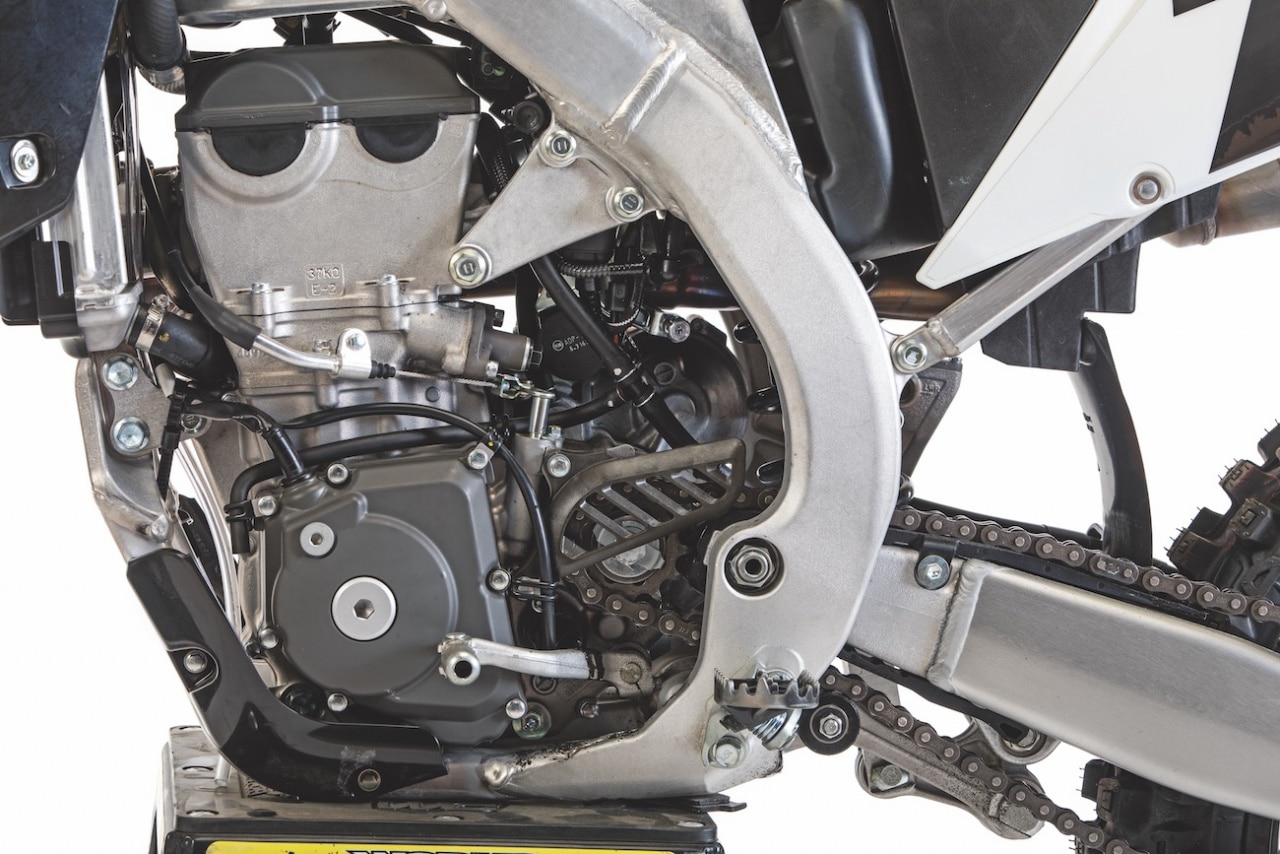
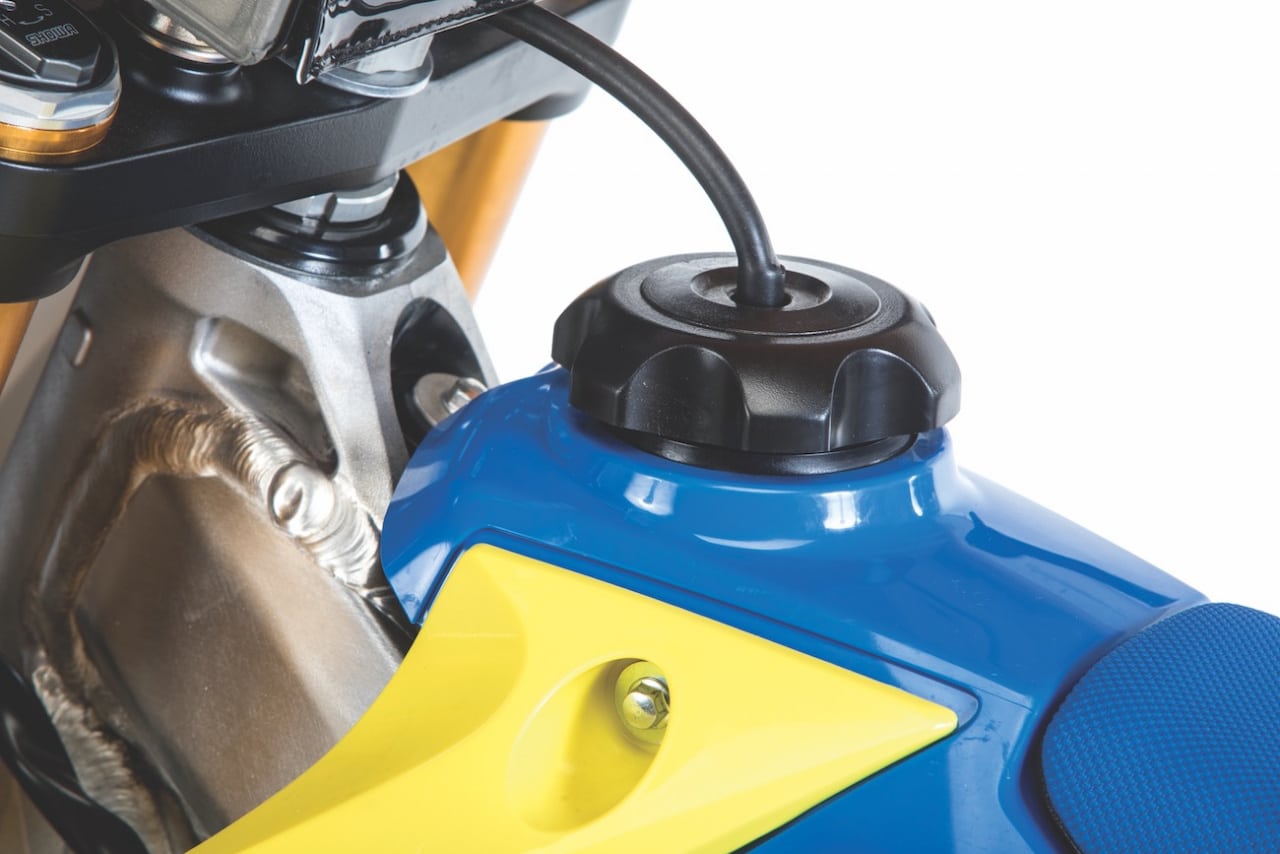

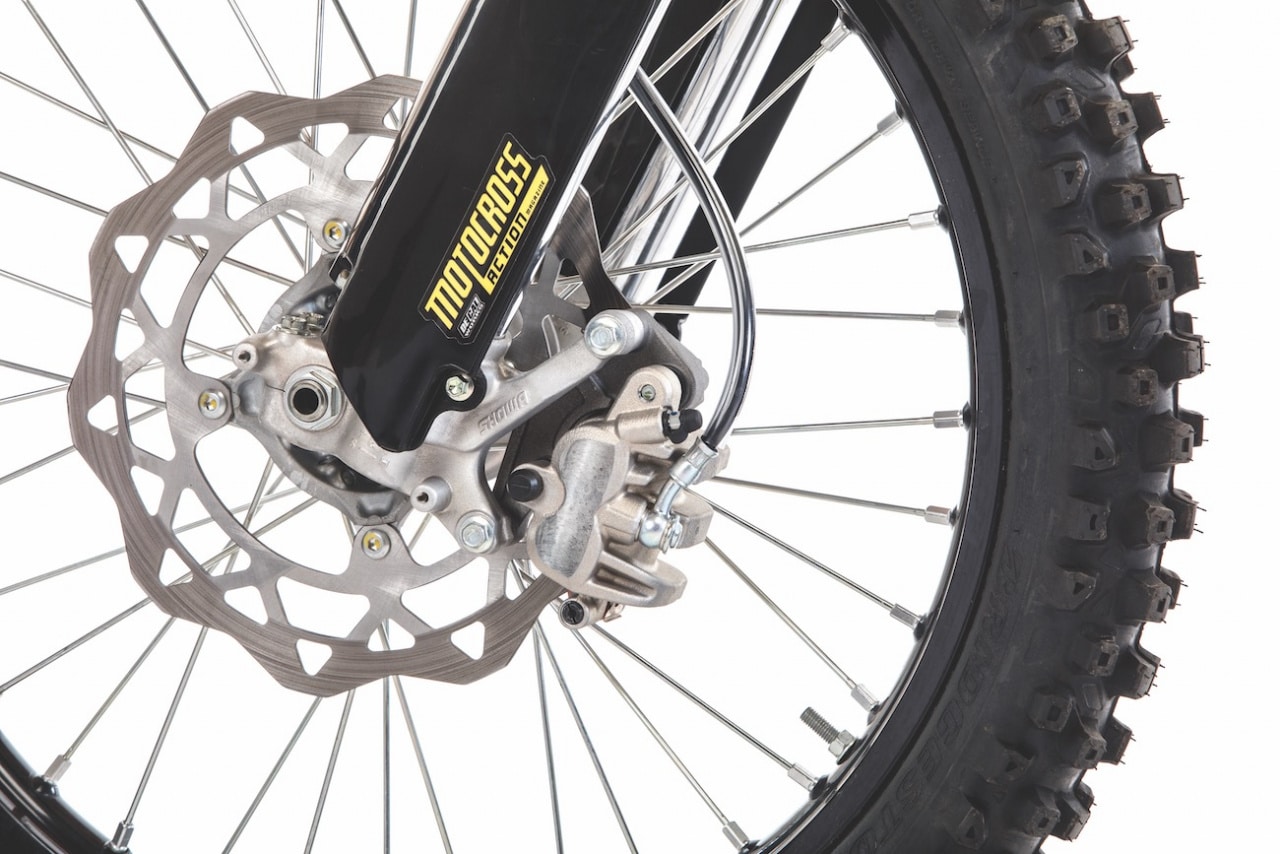

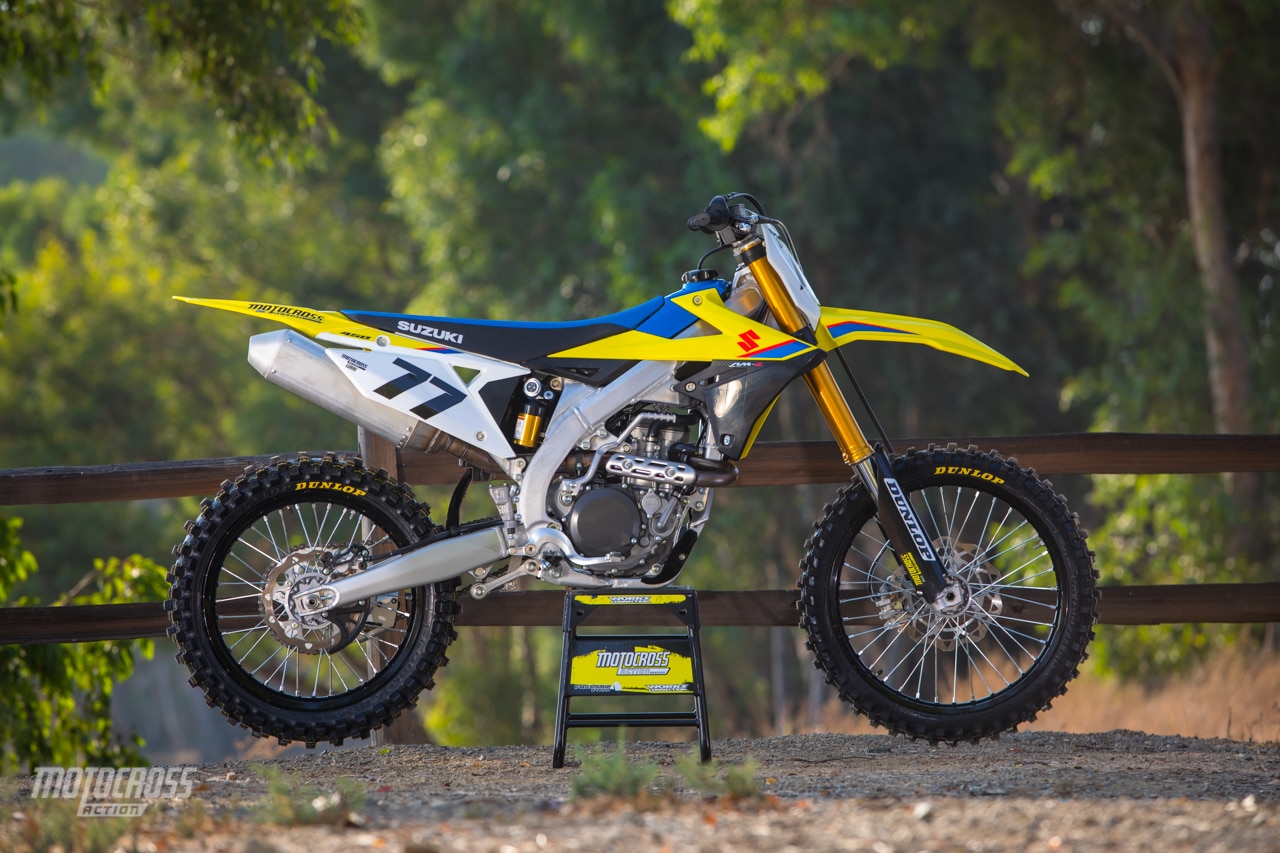



Comments are closed.